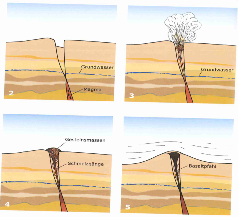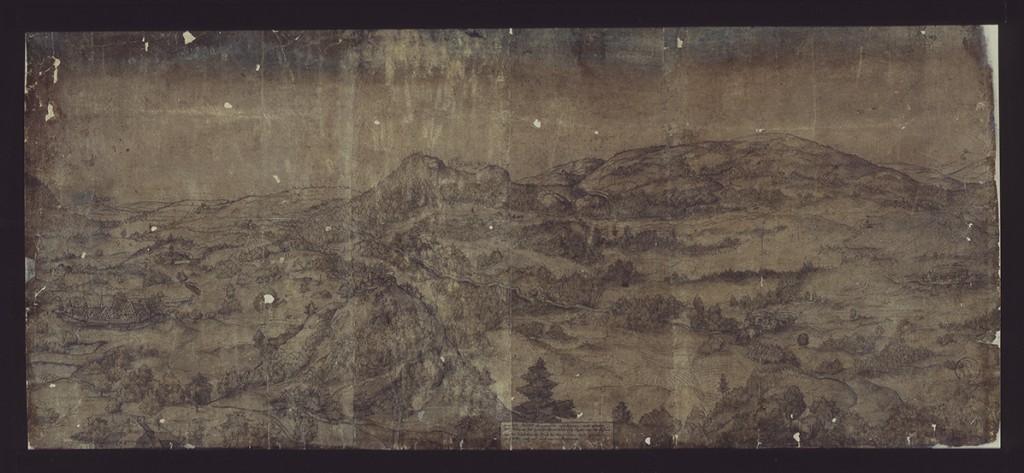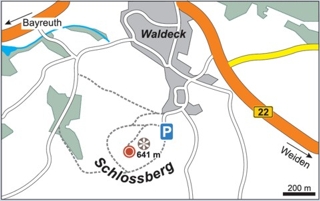



This project should provide an insight into the history of the „Schlossberg Waldeck“, from its foundation to present age.

The Waldeck local history and cultural society welcomes you to Waldeck. This small market town lies at the foot of the Schlossberg, a 641-meter-high mountain, in a volcanic landscape.
The Schlossberg is also of volcanic origin. However, it was not an active volcano but it is a basalt peak which was formed about 20 million years ago by tectonic movements when the Alps folded.
At that time earthquakes were common, rock layers broke and rock masses shifted resulting in violent explosions in the form of water vapour. The rock masses were accumulated in and around the crater and solidified to a hard basalt peak. This peak was surrounded by softer rock layers. The softer layers eroded in the course of millions of years of persistent weathering.
This is how the striking figures of the basalt mountains were formed, upon which one of the most powerful castles was built in the Upper Palatinate in the Middle Ages.
During the tour you will find out more about the history of the castle and the Schlossberg.
Let’s start with the tour, a journey through the centuries.

The recently rediscovered vaulted cellars under Waldeck Castle served as a storage place for food and other goods in former times. During 2013 and 2014, the tunnels were measured and officially documented. Today, some of these serve as a biotope and habitat for bat colonies.
In the past, the tunnels and vaults also captured people’s imagination and led to many a legend being told. In 1856, for example, the Kemnath chronicler Sigmund Ehrnthaller reported that Waldeck Castle used to be connected to the town of Kemnath by an underground tunnel and that these tunnels were only sealed up at around the end of the 18th century.
Legendary tales have tried to explain the origins of Waldeck Castle and its underground vaults. Reports dating back to the 19th century record the tale that claims that the castle was a place of pagan worship of the Goddess Nussa. Another story tells how the castle was believed to have Roman-Jewish roots, as in the 17th century a stone bearing a Hebrew inscription is said to have been found in the area of the castle.

Many centuries ago, the old market town of Waldeck was situated on this side of the Schlossberg mountain. No sources have been found relating to the initial development of the town. It is thought that Waldeck’s origins date back to the 12th century, when various servants and craftsmen came to settle here. It is likely that later on the inhabitants were also obliged to work at the castle for little or no pay in return for their lodgings. The town is first referred to as a Markt, a market town, in 1497. You can get an impression as to how this town influenced the landscape, by taking a look through our ’time window’ in which you can recognise the silhouettes of the houses. At that time, the Markt extended along the Schlossberg mountain.
In 1524, the townsfolk were awarded privileges regarding the lower legal jurisdiction, the free attainment of wood and the keeping of sheep, as well as the right to brew and sell beer.
In the night of the 24th to the 25th March, 1794, a heavy storm swept across Waldeck. Upon being struck by lightning, one of the houses caught fire. Due to the strong winds it was impossible to keep it under control, and within a few hours the whole Markt was in flames. 57 families lost their homes in this tragedy, but on the same day, the townsfolk were already talking about rebuilding. It was agreed that the new Markt would not be rebuilt on the same site, but on the other side of the castle in Horitz, on the trade route between Franconia and Bohemia.

The medieval chapel was dedicated to Saint Giles, whose popularity in the diocese of Bamberg and Regensburg markedly increased from the 12th century onwards. This saint was particularly popular among knights and noblemen, which is of course why several castle chapels are named after him. In Waldeck, the church service was initially held by the priest of Kastl.
In 1674 Waldeck was assigned its own curator whose place of residence was also in the town. The town (Markt) became an independent parish in 1690; the castle chapel became the first parish church.
The history of the castle chapel being the parish church ends with the War of the Spanish Succession and the consequent demolition of the fortress in 1704. The detailed eyewitness account of the parish priest, Pfarrer Weiß, recounts the bombing of the castle and the looting of the bells of St.-Giles’ Church. The priest was only able to save the robes, the chalices and the altar before the church was damaged.

In 1283, Waldeck was sold to Ludwig den Strengen, Herzog in Bayern and Pfalzgrafen bei Rhein (Ludwig the Severe, Duke of Bavaria and Count Palatine of the Rhine) from Wittelsbach. The castle now became the residence of a duke. In 1329, according to the Treaty of Pavia, the castle and administrative district were signed over to the Wittelsbach-Palatinate before being assigned to the ‘Vitzthum’ of Amberg in the 15th century.
Due to its significant status, the castle was involved in many disputes over the years.
It was especially during the Thirty Years’ War (1618-1648) that the castle was reconstructed and besieged many times. The worst attack was carried out by Swedish troops in 1648. From 13th to 15th July they opened fire on the castle and prepared to storm it by bombarding it with grenades and stones made of mortar. On 15th July the district magistrate Quesnay finally surrendered and the Swedes occupied the castle. It wasn’t until a year later that they finally withdrew.

In the 16th century, wells were also dug here and the fortifications were extended further. This is probably why Waldeck Castle did not lose its importance straight after the fire at the main castle in 1665. Although the inner castle area was never rebuilt, the two outer castles were still used and maintained.
At the beginning of the 18th century, the War of the Spanish Succession was approaching. In the autumn of 1703 the Upper Palatinate was almost entirely in the hands of the imperial troops. Only in Waldeck an army of the Electoral Palatinate was still trapped by the enemy. The siege began in July 1704, and two months later, on 17 September, the castle commander surrendered.
The following year, the final demise of the castle began. The imperial government decided to „demolish Waldegg Castle“ and on 29 September 1705, all demolition work had been completed.

A special feature of Waldeck Castle is the fact that not only a noble family or their vassals lived there, but also the administrator of the castle from the Obernburger family. Their name probably derives from the oldest area of the castle, the upper castle (superiori castro). While one family lived in the main castle, the second fortified residence is assumed to have have been near the old market gate in the outer castle.
In 1665, more than half a millennium after Waldeck Castle had been mentioned for the first time, a fire broke out in the ‘Pfaffenstube’ of the the upper castle. The fire spread rapidly and also reached the powder magazine in the keep. Only after this exploded did they finally attend to fight the fire. The upper castle, however, was by now already completely burnt out and was not rebuilt. By the time the castle was given up completely, only the areas of the two outer castles were being used.

According to history, in 1596 the village council of Markt Waldeck submitted an official written request to the Count Palatine for the village to be able to build its own cemetery. However, a reply was not received. Three years later Hans Lankhammer died of an illness related to the pest. Fearful of spreading the infection, noone was prepared to transport the body to the parish of Kastl for burial. The priest therefore decided that the villager should be buried in a field near the Markt. This was the first burial in Waldeck.
The owner of the field then offered to sell the ‘Pestacker’ (pest field) to the village council. They accepted his offer and wrote to the Count Palatine asking for permission to be able to use the field as a cemetery. He consented to this and a wall was built around the field. Until 1803, the Old Cemetery was the final resting place for the inhabitants of the old market town (Alter Markt), and also until 1912 for those living in the parish.

This history of the new Markt is closely linked to that of the castle area. At the end of the 18th century, the village council was already planning to purchase the castle and ruins from the Bavarian state. In 1914 and 1951 plans were even being made to use the area as a quarry. In 1973 the castle was classified as a protected historical monument.
In the 80s, volunteers and local citizens initiated the ambitious move to reconstruct the ruins; this project was of considerable importance for those living in and around the area.

In the Middle Ages, it was common for the ruling landowner to assign an administrator, or Pfleger (caretaker), for every administrative district. These were responsible for the administration and defence of their estates, as well as the jurisdiction. In the late Middle Ages, the term Landrichter (district judge) became officially recognized. The judges of Waldeck were also appointed by the Wittelsbachs as their representatives who, if and when necessary, had the power to remove them from office.
In the administrative district of Waldeck, the judges resided and worked in the upper castle. The first official from Waldeck, ‘Albertus, officialis in Waltecke’ appeared on 4th November, 1272 as a document witness.
At the beginning of the modern era, the district court was transferred to the town of Kemnath. Although initially the judge resided at the castle, Waldeck gradually lost its central role as a military and administrative hub after the administrative centre was moved to Kemnath.